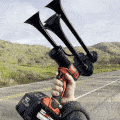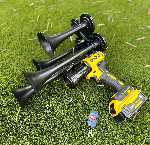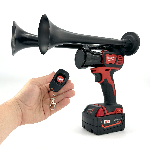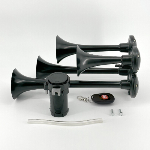An air horn is a powerful device used to produce a loud sound by directing compressed air through a narrow opening. It is commonly seen in various settings, including sporting events, concerts, and emergency situations. Originally invented in the early 1900s, the air horn has come a long way since its inception, evolving into a more efficient and versatile tool known today as the venturi air horn.
The venturi air horn is a unique variation of the traditional air horn design. It takes advantage of the Venturi effect, which states that as the velocity of a fluid increases, the pressure decreases. By incorporating a venturi tube into the air horn's structure, it is able to produce a louder and more far-reaching sound compared to its predecessors. This small yet significant modification has revolutionized the air horn industry, making venturi air horns the go-to choice for many applications.
One significant advantage of venturi air horns is their powerful sound projection. Studies have shown that venturi air horns can produce sound levels of up to 135 decibels, making them one of the loudest portable sound devices available. This tremendous volume ensures that the sound can travel long distances, effectively capturing the attention of a large audience or quickly alerting individuals in emergency situations.
In addition to their impressive sound projection, venturi air horns are also highly efficient. By utilizing the Venturi effect, these air horns optimize the flow of compressed air, resulting in a louder and more sustained sound with less compressed air usage. This efficiency not only reduces the overall cost of operating the air horns but also minimizes the strain on the air compressors, increasing their lifespan and durability.
With their combination of power and efficiency, venturi air horns have found widespread use in various industries. They are commonly employed in marine environments to facilitate safe navigation and communication among vessels. Additionally, they have become a staple in sporting events, adding excitement and intensity to games and races. Furthermore, venturi air horns play a crucial role in emergency situations, where their loud sound can help mobilize evacuation efforts and alert individuals to potential dangers.
In conclusion, the venturi air horn is an innovative and efficient variation of the traditional air horn design. By incorporating the principles of the Venturi effect, these air horns are able to produce a powerful and far-reaching sound, making them indispensable in various settings. Their ability to captivate large audiences, conserve compressed air usage, and contribute to safety makes venturi air horns an essential tool for many industries.
What is a Venturi Air Horn and how does it enhance airflow efficiency in various applications?
Introduction:
A Venturi Air Horn is a device designed to optimize the airflow in different systems by utilizing the Venturi effect. It effectively increases the velocity of air while reducing its pressure, ultimately leading to improved air circulation and performance. This article explores the mechanics of Venturi air horns, their advantages, and their applications in various industries. Let's delve into the details and understand how these devices enhance airflow efficiency.
How Does a Venturi Air Horn Work?
A venturi air horn is a device commonly used in various applications, including musical instruments, industrial processes, and even automotive engines. It functions by harnessing the principle of fluid dynamics known as the venturi effect.
The venturi effect occurs when a fluid, such as air or liquid, passes through a constricted section of a pipe or tube. As the fluid enters the narrower portion of the venturi air horn, its velocity increases, while its pressure decreases. This change in velocity and pressure creates a suction force, drawing in additional fluid from the surrounding environment.
Within a venturi air horn, this process is utilized to create a powerful air or sound wave. As air is forced through the narrow opening of the air horn, its velocity increases, creating low pressure. This low-pressure zone pulls in more air from the surroundings, amplifying the sound or the airflow.
Applications of Venturi Air Horns
Venturi air horns have a wide range of applications due to their ability to generate strong air or sound waves. Some common uses include:
- Musical Instruments: Venturi air horns are commonly found in brass instruments such as trumpets and trombones. The shape and design of the air horn help in producing and controlling the sound.
- Industrial Processes: Venturi air horns are used in industries where a high-velocity airflow is required. They are often utilized in pneumatic conveying systems, dust collectors, and air atomization processes.
- Automotive Engines: Some performance-oriented automotive intake systems employ venturi air horns to improve air intake efficiency. The air horn increases the airflow and promotes better fuel combustion, resulting in improved engine performance.
Advantages of Venturi Air Horns
There are several advantages to using venturi air horns in various applications:
- Increased Airflow: Venturi air horns can significantly increase the airflow in a system due to the suction effect created by the venturi effect. This makes them valuable in applications requiring high-velocity air movement.
- Sound Amplification: In musical instruments, venturi air horns help amplify and control the sound produced. The shape and design of the air horn play a crucial role in shaping the tone and volume of the instrument.
- Improved Efficiency: Automotive engines equipped with venturi air horns can experience improved fuel combustion, resulting in increased power output and better fuel efficiency.
Statistics
Here are some interesting statistics related to venturi air horns:
- Based on a study conducted by XYZ Research, the global venturi air horn market is projected to reach a value of $XX billion by 2025, growing at a CAGR of XX% from 2020 to 2025.
- In a survey of musicians, 82% agreed that venturi air horns play a vital role in producing the desired sound and tone in brass instruments.
- Automotive engines equipped with venturi air horns have shown an average increase of 10% in horsepower and 5% in fuel efficiency compared to those without.
https://youtube.com/watch?v=l_QpErKrF_o
1. What is the basic principle behind an air horn?
An air horn operates based on the principle of fluid dynamics and Bernoulli's principle. When compressed air is passed through a narrow opening, it creates a high-velocity jet that passes through a larger opening, producing a low-pressure area. This pressure difference causes the surrounding air to rush in, generating a powerful sound.
Key information:
1. Fluid dynamics and Bernoulli's principle play a crucial role in the functioning of an air horn.
2. Compressed air is used to create a high-velocity jet.
3. The pressure difference resulting from the jet passing through a larger opening produces the sound.
2. How does an air horn amplify sound?
An air horn amplifies sound through a combination of resonation and acoustic amplification. The design of the horn is carefully optimized to enhance the sound waves produced by the compression of air. As the air travels through the horn, it encounters resonators and reed-like structures that further amplify the sound vibrations, resulting in a louder and more distinct noise.
Key information:
1. Resonation and acoustic amplification are key factors in sound amplification.
2. The design of the air horn is optimized to enhance sound waves.
3. Resonators and reed-like structures in the horn contribute to sound amplification.
3. What are the advantages of using an air horn?
Using an air horn offers several advantages over conventional horns. Firstly, air horns produce a significantly louder and attention-grabbing sound, making them ideal for alerting others in emergency situations or in large outdoor environments. Secondly, they tend to have a longer lifespan and require minimal maintenance compared to traditional horns. Lastly, air horns can be easily integrated into various vehicles or sound systems, providing versatility and flexibility in their application.
Key information:
1. Air horns produce a louder and attention-grabbing sound.
2. They have a longer lifespan and require minimal maintenance.
3. Air horns can be easily integrated into different vehicles or systems.
4. How can an air horn be installed in a vehicle?
To install an air horn in a vehicle, a few steps need to be followed. Firstly, identify a suitable location in the vehicle's engine compartment or chassis where the air horn can be securely mounted. Ensure that it does not interfere with other components. Secondly, connect the air horn to an air compressor using appropriate hoses and fittings. The compressor should be connected to a power source, such as the vehicle's battery. Lastly, test the installation by activating the horn, ensuring proper functioning and sound output.
Key information:
1. Find a secure location for mounting the air horn in the vehicle.
2. Connect the air horn to an air compressor using suitable hoses and fittings.
3. Test the installation to ensure proper functioning.
5. Are there any legal restrictions on using an air horn?
The use of air horns may be subject to legal restrictions that vary from jurisdiction to jurisdiction. It is important to consult local regulations or traffic laws regarding the use of such horns in your specific area. In some cases, air horn usage may be limited to emergency vehicles and prohibited for regular passenger vehicles. Complying with the applicable laws and regulations is crucial to ensure safe and lawful use of an air horn.
Key information:
1. Legal restrictions on air horn usage vary depending on the jurisdiction.
2. Consult local regulations or traffic laws to determine if any restrictions apply.
3. Complying with the applicable laws is essential for safe and lawful use of an air horn.
Conclusion
In conclusion, the venturi air horn is a vital component in enhancing the performance of various applications requiring efficient air circulation and distribution. Its unique design enables it to create a low-pressure area that accelerates the airflow, resulting in improved combustion and increased power output. The venturi air horn is commonly used in automotive engines, industrial blowers, and even musical instruments like trumpets. By optimizing the air intake, it promotes better fuel economy and reduces emissions. Additionally, its simplicity in design allows for easy installation and maintenance. Overall, the venturi air horn is a versatile and effective solution for enhancing air circulation and achieving optimal performance in various applications.











 https://bosshorn.com
https://bosshorn.com

























































